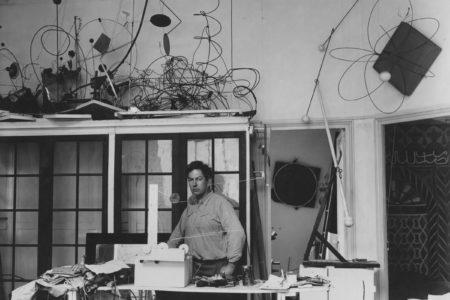Filter 382 results

Kuh, Katharine. “Alexander Calder.” In The Artist’s Voice: Talks with Seventeen Artists. New York and Evanston, Illinois: Harper & Row, 1962.
Featured Text
1930–1936: Shift to Abstraction
Timeline
Following a visit in October of 1930 to Piet Mondrian’s studio, where he was impressed by the environmental installation, Calder made his first wholly abstract compositions and invented the kinetic sculpture now known as the mobile. Coined for these works by Marcel Duchamp in 1931, the word “mobile” refers to both “motion” and “motive” in French. He also created stationary abstract works that Jean Arp dubbed “stabiles.”
The Foundation
The Foundation
Works of Calder
Produced by New World Film Productions for the Museum of Modern Art, New York. 16mm, color, sound (English); 20 min. Directed and cinematography by Herbert Matter; produced and narrated by Burgess Meredith; music by John Cage.
Alexander Calder: From the Circus to the Moon
16mm, color, sound (English); 12 min. Produced and directed by Hans Richter; cinematography by Arnold Eagle.
Alexander Calder: Sculpture and Constructions
Produced by the Museum of Modern Art, New York. 16mm, color, sound (English); 10 min. Written and narrated by Agnes Rindge Claflin; cinematography by Herbert Matter; filmed and recorded by Hartley Productions.
Work in Progress
16mm, color reversal film original, silent; 14:40 min. Cinematography by Giulio Gianini. Unedited footage of first performance of Work in Progress (Teatro dell’Opera, 1967–68)....
3–25 December 1940
Chronology“Calder Jewelry” is presented at Willard Gallery, New York. In her press release for the show, Willard writes, These works of art are savage and deliberate and self-confidently sophisticated . . . This is a master modern artist’s contribution to the history of fashion. For a world already in
chains it is superb stuff.
Spring 1969
ChronologyJaney Waney, commissioned by the N.K. Winston Corporation, is installed at the Smith Haven Mall in the Long Island village of Lake Grove. The force behind the site-specific project is the developer’s wife, Jane Holzer—or “Baby Jane,” a star of Andy Warhol’s films––for whom the sculpture was named.
